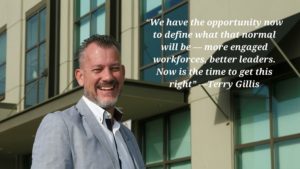Ready or not, here it comes
After more than a year of remote work, the future looks hybrid. How local firms are stepping up to the challenges and redefining what it means to work
REMOTE WORK IN the pandemic is making many workers miserable. They feel tired, overworked, spend way too much on video calls that have grown longer and longer over the past year.
Four out of every 10 workers say they are considering leaving their jobs. People throughout the workforce complain that work from home has come to mean living at work. Our social and professional networks are contracting, and burnout is on the rise. If you are young, at the start of your career, a woman or a racialized person, this picture simply gets bleaker.
Click here to view this story in magazine format.
These, at least, are the dispiriting findings of Microsoft’s first Work Trend Index, released in late March, which polled 30,000 people in 31 countries, and used data collected through the Microsoft Teams and LinkedIn (which Microsoft owns).
“People are in significantly more meetings, taking more ad hoc calls and managing more incoming chats than they did before the pandemic,” the study found. “One third of remote workers say the lack of separation between work and life is negatively impacting their wellbeing.”

Terry Gillis, president of London-based Ahria Consulting and the author of the book Desuckify Work, isn’t surprised that many workplaces struggled to adapt to remote work, since so many workplaces were bad at managing their workplaces to begin with. He sees the coming of hybrid work as a once-in-a-generation chance to improve on the culture of work.
“I could talk to you for hours about this stuff,” he says. “That’s why I wrote the book — because work sucks and nobody seems to be paying attention to making it right.”
But it’s also clear by now that remote work is here to stay, in some form or another. For every worker who has struggled with remote work there is another who thrives on it. Flexibility in work is now an expectation: 70 per cent of workers want to have remote work options, while 65 per cent want more in-person time.
Story Continues Below
In Canada, the workforce is very clearly split. In a poll taken last fall, 31 per cent of Canadian workers expressed a desire to return to the office, while another 32 per cent said that if remote work was taken away, they would quit.
Against this backdrop, local companies have forged new structures that are going to guide their growth as we come out of the pandemic. What is clear, if nothing else, is that there is no single experience of remote work — and that if hybrid work is here to stay, it will require both employers and employees to develop new ways of working in order to be sustainable.
MANY OF US can, by now, recall pandemic days where Zoom meetings dragged into dinner hour, or where meetings felt like unnecessary and often lengthy interruptions to the workday.
At Voices.com, those tendencies forced them to make changes early.
“Going into that first summer, our meetings got out of hand,” says Randy Rektor, a content producer at the company. The video calls were getting longer, he recalls, there were more of them and people were required to be in meetings that didn’t really concern them. People were getting stressed out.
The key to turning things around was that they caught it quickly and listened to their employees. Management was already in the habit of sending around employee surveys, Rektor explains, and in a company-wide meeting addressed the issues that many of their employees had been raising, promising to bring in changes to address the concerns. The company set aside times each week in which no meetings could be scheduled, giving people uninterrupted work hours. They also engrained in their workforce “to think about who you’re inviting” to meetings, Rektor says.

What works for Voices is clear policies and expectations, and importantly, giving employees the ability to set boundaries.
“Tactically speaking, the first thing employers can do is encourage employees to set work hours in their calendar system,” says David Ciccarelli, Voices.com CEO. But flexibility matters, too — especially for parents.
“We found the best policy is honesty, so if you have to jump out of a meeting to log your kids into a virtual learning environment, then just say so,” he says. “No need to give an excuse, it’s just something you need to do, and everyone is understanding.”
Those workplaces that have had success with designing remote and hybrid work arrangements tend to see it as a source of opportunity rather than a liability — a way not only to keep your employees happy, but to let them work better, too.
Story Continues Below
Voices.com recently announced a new work-from-anywhere policy. Rektor, for instance, works Monday to Wednesday in the office, Thursday and Friday at home. “I found that balance was fantastic,” he says. “I would schedule certain tasks depending on where I was going to be,” and “that Wednesday afternoon really feels like a Friday.”
He thinks many of his coworkers will feel the same, an attitude that was noticed by management.
“People were thrilled — especially after having established new routines in their homes during the pandemic — that we are offering this on an ongoing basis,” Ciccarelli says. “We’ve been able to adapt our hiring methods, recruiting tech talent from across the province.”
FOR OTHER LOCAL companies, working from home has sparked bigger changes at the company.
When the pandemic hit, digital agency 44 North Digital Marketing had just begun flirting with work-from-home arrangements, largely at the behest employee Jillian Mathies. She was the first in the company to take her work remote, about a year before the pandemic, when she was moving with her partner and didn’t want to leave her job.
“I thought, ‘Huh — what if I just pitched [Corey] on it?’” she recalls now. “Everything we do is digital anyways.”
“At the time, I was quite apprehensive about it, thinking it wouldn’t work out,” says firm founder and president, Corey Shelson.

He recalls the usual fears creeping in. “Are your people going to be working? Are they going to be slacking off, abusing the time? That was my initial reaction — this feels like it’s going to be a disaster.”
But none of those fears came to pass. “It worked,” Shelson says. “There were no issues — she was super productive.”
So, when Covid hit and the great work-from-home experiment kicked off, Shelson says, “We kinda had a year of this remote working thing under our belt.”
For Shelson, a former military engineering officer with the Canadian Armed Forces, the success of their work from home system grows out of a dedication to healthy structure. “When your work is at home, it’s hard to walk away,” he says. “We had to be pretty strict in terms of protecting our staff and their well being.”
They have managed to keep their work hours strictly defined — just as an employee is expected to show up on time, they can also expect their workday to end on time, and managers are strict about not messaging people after 5 p.m.
Story Continues Below
Recently, North 44 introduced flex hours to their remote working — a couple of hours every day that can happen whenever.
“The catalyst for the flex hours was the shutting down of schools,” Shelson explains, noting that some of their employees are parents, some aren’t; some work best in the morning, some at night; some might want to work out in the middle of the day and make up the hours on the back end. When Shelson implemented these flex hours first in his own home — two hours a day to alleviate the parenting burden on his partner — it just made sense to expand it across the company.
“That flexibility in their day allows them to create a routine with their own families,” he says. “Working remote can work, but you’ve got to put some extra time and care into the culture aspect of it. You put your people first, and you take care of those people.”
IF THERE IS a common thread that ties together the successful work-from-home adaptations, it is probably workplaces realizing that the old playbook wasn’t going to work anymore, and that new arrangements would need to be designed.
“Organizations can’t continue to operate the same way as before, and treat employees like they are assets,” Gillis stresses. Early in the pandemic, he says, he had people come to him and ask how they could monitor their employee’s productivity, how to check up on them remotely — an attitude that he sees as a holdover not just from pre-pandemic days, but from the efficiency-obsessed industrial factories from a century ago.

“We’ve got to make it better, and I think we can — that’s the point,” Gillis says. “We can if we get out of our own way and we focus on what really needs to happen. Stop getting into this master-servant power dynamic relationship, where the bosses have the power and the employees are the minion, and actually look at it as a bit of a partnership.”
Gillis’ message to employers is simple — this isn’t just a pandemic story. It’s not just Zoom calls or emails after hours or remote work that is making it this way — those are simply magnifying problems that existed before the pandemic, and that will continue to exist in hybrid workplaces if we let them.
Story Continues Below
As we start to talk about a return to normal, Gillis says it’s important to be clear about what that means. Hybrid work should not mean the same workplace culture moved part-time into the home, but a new kind of work that leverages flexibility into more sustainable practices.
“I don’t advocate that we go back to normal, in the sense that normal is defined by 2019,” he says. “We have the opportunity now to define what that normal will be — more engaged workforces, better leaders. Now is the time to get this right.” ![]() Kieran Delamont
Kieran Delamont

